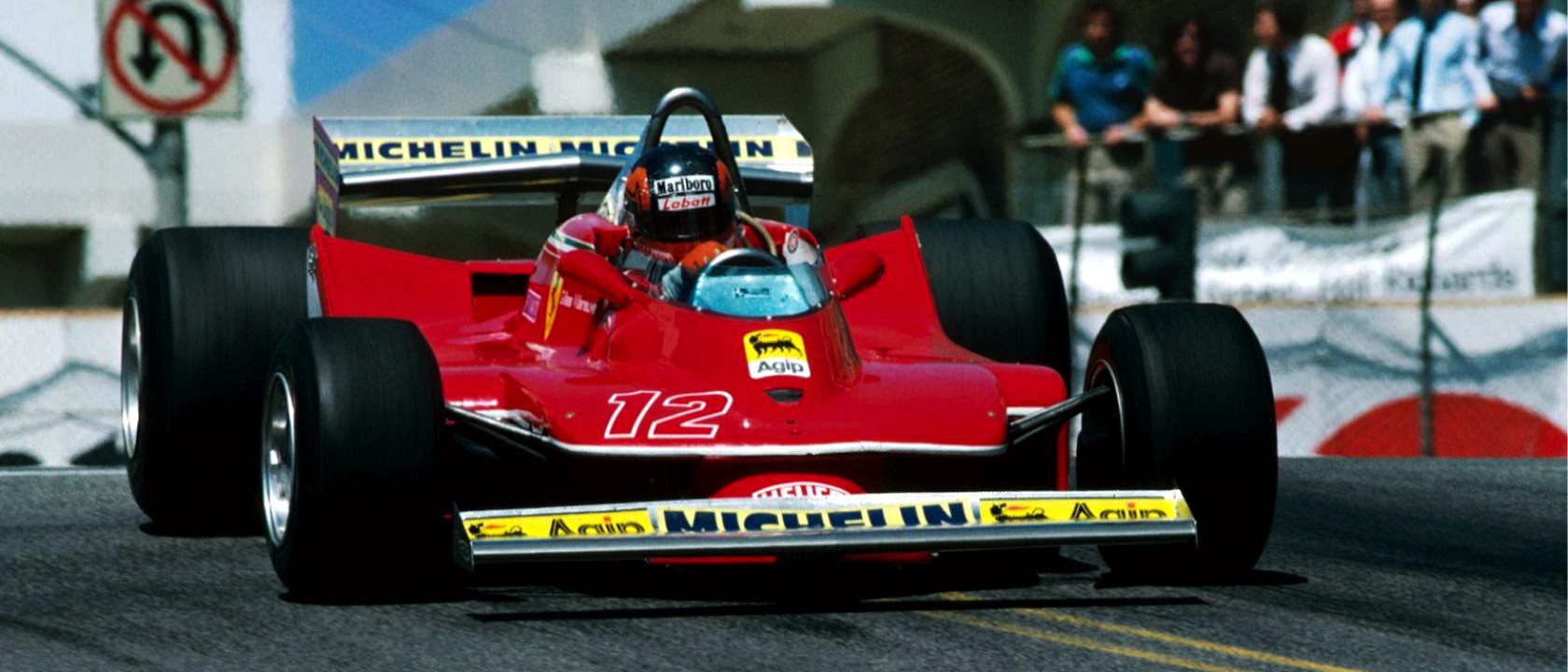


Ferrari 126C 1981
“Salut, Gilles” is written on the track at the start-finish line of the Montréal Grand Prix circuit named after him. Some have thought that Gilles Villeneuve personified everything good about motor racing, his astonishing natural speed complemented by a diminutive physique coupled with a boyish face and irreverent character. Others said his flamboyance bordered on the reckless. Both are perhaps  right, as this dearly loved driver won the hearts of the Ferrari Tifosi — to whom he is still revered today — and was affectionately called the “High Priest of Destruction” by the commendatore himself, Enzo Ferrari. Gilles had a talent for taking anything mechnical and “utterly destroying it,” according to Ferrari, who compared Villeneuve’s will to win to that of the legendary Tazio Nuvolari of the 1930s.
right, as this dearly loved driver won the hearts of the Ferrari Tifosi — to whom he is still revered today — and was affectionately called the “High Priest of Destruction” by the commendatore himself, Enzo Ferrari. Gilles had a talent for taking anything mechnical and “utterly destroying it,” according to Ferrari, who compared Villeneuve’s will to win to that of the legendary Tazio Nuvolari of the 1930s.
Rocketing to prominence in the Formula Atlantic scene in the mid-1970s, after beginning his career as a professional snowmobile racer, Villeneuve replaced Niki Lauda at Ferrari for the end of the 1977 Formula One season. Remaining with the Scuderia for his full career, Gilles’ statistics (just six wins and 2 poles in six seasons) appear paltry beside his reputation. But a closer look reveals that Villeneuve had such raw natural talent and an enthusiasm for GP racing that the World Championship would surely have been inevitable. He scored his first win at the Canadian Grand Prix the next season, and in 1979 posted three wins and seven podium finishes while standing honorably by team orders — driving nearly the entire race in 2nd place — at the Italian GP at Monza so that team mate Jody Scheckter could win the title. Described then as “perhaps the most tenacious fighter seen in racing for years,” Gilles took 2nd place in the World Championship by a slim four points and in the ’79 French Grand Prix, won by Jean-Pierre Jabouille in the first victory for a turbocharged engine in the modern F1 era, waged a fantastic duel with René Arnoux for second place, with Villeneuve crossing the line 0.3 seconds ahead (in the first race announced by Murray Walker for the BBC). Niki Lauda once said, “He was the craziest devil I ever came across in Formula 1.”
Saddled with an inferior car, Gilles nonetheless won at Monaco in 1981 — pictured above — and in the Spanish GP two seeks later. That would sadly prove to be his last F1 victory, however. Just as the Scuderia were developing a promising turbo engine for themselves, the FOCA-FISA controversy led to a virtual boycott of the 1982 San Marino GP. There, in a far from full field of just 14 entries, the Ferrari 126C2 turbos were running 1-2, with Villeneuve leading from Didier Pironi, when the team
Dijon is my best memory of Grand Prix racing. Those few laps with Arnoux were just so fantastic to me — out-braking each other and racing for the line, touching each other but without wanting to put the other car out. It was just these two guys battling for second place without trying to be dirty but having to touch because of wanting to be first. I loved that moment.
— Gilles Villeneuve —
That would not happen. Consumed with dismay and disbelief at being betrayed, Gilles was determined to beat Pironi in the Dutch Grand Prix at Zolder two weeks later. Taking the track in practice to top Pironi’s slightly faster (0.1s) qualifying time, Villeneuve was on a hot lap when the dawdling March of Jochen Mass strayed into his path. Unwilling to lift, Villeneuve ducked inside but was launched over Mass’ left rear wheel, the Ferrari instantly cartwheeling to destruction across the track, nose in the sand, flinging the driver out of the cockpit. The suicide-in-installments that was Villeneuve’s life had reached its final phase, driving Enzo Ferrari to tears and leading Villeneuve’s own son, 1997 World Champion Jacques, to adopt a calculating and far different approach to the “art and genius” of Grand Prix racing. As Nigel Roebuck of Autocourse wrote in 1982, “Gilles has gone, and with him the light of genius in Grand Prix racing. In time, of course, another star will emerge, but it will never twinkle with the same intensity again. We are back to normality once more. The impossible cannot happen.” At the funeral in Berthierville, former teammate Jody Scheckter delivered a simple eulogy: “I will miss Gilles for two reasons. First, he was the fastest driver in the history of motor racing. Second, he was the most genuine man I have ever known. But he has not gone. The memory of what he has done, what he achieved, will always be there.”
| Gilles Villenevue’s Career Profile | ||||||
| Seasons | Races | Wins | Poles | Fastest Laps | Points | F1 Titles |
| 6 | 67 | 6 | 2 | 8 | 107 | 0 |
Other Gilles Villevenue Sites
Wikipedia Article
Biography by Dennis David
BBC’s Greatest F1 Drivers
GP Encyclopedia
AutoSport—F1’s Greatest Drivers
ESPN F1 Profile
McLaren Heritage Profile
Profile by F1 Grand Prix History
Gilles Villevenue Video
For the Love of Speed |
Legends of F1 |
Dijon 1979 |


